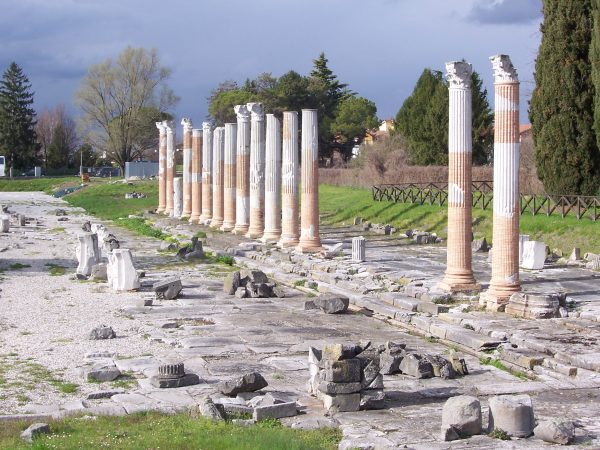Once an important roman town, Aquileia is now a small city in Italy flanking the lagoons on the river Natiso at a distance of 10 km from the sea. Founded in 181 BC as a Roman colony mainly to facilitate the trade routes of the north as well east, today, the city is among the principal archeological sites in the north zone of Italy despite that it off the main tourist locations in the nation. It is nestled in the Friuli-Venezia Giulia region of the Udine prefecture.

Currently, there are no Roman constructions seen on the ground except for the excavated vast Basilica that reflect the Roman past. Probably, Aquileia is still to be excavated, but whatever archaeological work has been done until now is completely attributed to the myriad of the underground tombs. This means that much of the data related to the city as well as the site has been obtained via these tombs. It is believed that this UNESCO World Heritage site is the largest Roman site, which will be proved when it will be completely discovered.
Until now, besides the tombs, a few ancient edifices exist at Aquileia, which has acted as stone quarries since countless centuries. The carried out excavations have found out a street as well as a north-west angle as a part of the town walls. There is also the National Archaeological Museum that is among the most vital museums of the old Rome on the planet. Although the next best is Ephesus Museum in Turkey, Aquileia museum is simply the “one”. It is the home of more than 2,000 inscriptions, artifacts, statues, numismatics collection, and local production.

Although not much have been found, you definitely have to see much in Aquileia: two museums, the basilica’s popular mosaic, and the outdoor sites. At a distance of some yards off the vital road, Piazza Capitolo is the main, big, and scenic square holding the large basilica as well as a giant white campanile (belltower) of the 11th century.
Yet utilized for the religious services, the basilica’s interior is high and that the columns flow until the frescoed apse. Look out for the most remarkable feature – the big mosaic floor of the 4th century. Be on the glass walkway of the either sides of the nave to adore the decoration without any harm. The mosaic denotes a contest of a cockerel (light) and tortoise (dark), seasons, and portrayals of the faces who contributed for the edifice. The top attractions in the basilica are its two crypts where the excavated artifacts reside. Take a ticket from a staff member to visit these subterranean chambers. One of them is called ‘Fresco Crypt’ located near by the altar and holding some notable 12th-century frescoes. The second one is the ‘Crypt of the Excavations’ accessible via a doorway to the entrance’s left. Here, you will come across many levels of archaeology such as the geometric mosaics, terracotta flooring of the earlier complex of the basilica, and the 4th century mosaic.
Coming to the outdoor archaeological areas, they are many encircling Aquileia and many excavations are in progress. The sites that are open to the public are free of charge and boast the information boards. However, the visit is only allowed during the day. Despite the fact that these ruins and tombs give you a brief understanding of the city’s ancient extent, they are actually not the most stunning relics that you will come across in Italy. Among the ruins, you will see some low walls, some reconstruction work, and some weathered mosaics. But yes, a visit to the Roman river port is not to be missed as a large area has been discovered, which indicates about the hustle and bustle of the port long ago. It has been found that the goods were unloaded from the ships at the nearby Grado and were then transmitted via the smaller vessels on the broad River Natiso to reach this port.
Aquileia’s forum has also been unearthed, which now lies by the side of the main road. A few columns have been remade. Check out the Museo Archeologico Nazionale that is situated on the main road accessible by a short distance from the Basilica. This is where you can see some outstanding displays of the archaeological finds adorning the three floors. Despite the fact that not much labeling is done on these exhibits, they are worth a watch. Some of these items are beautiful carved gems of the workshops, Roman jewelry such as necklace of small gold shells, and the small gold flies.
Go still ahead down the street and look for the signposts that will take you to the Sepolcreto that is a remade extent holding five tombs of a family. Nestled in a plunge at the rear of the back-gardens, this tourist zone has a bizarre uptown feel. From here, just amble back in the direction of the main road, where you can enjoy the mountain views above one more unfinished excavation.
Visiting Aquileia is a day trip, which is possible from Trieste and Venice. As the sites are scattered, it is advisable to take a map from the tourist office to track them.
